Here are a few Jazz
lessons to get you started.
A few Lessons for Jazz Ukulele to Get Started With
All available lessons tagged with the subject of Jazz.

Beyond basic open position chords, basic movable form chords, and a core set of 4-part chords. There are just too many chords shapes too memorize. Learning the principles of how chords are constructed and the ukulele fingerboard are the way to go. You can then create more advanced chords like 9#11, 7#5-9, 13b5, 7+9 on the fly as needed from your core set of chords.

The Big Six Core Chords is a series of lessons for building your core, essential 4-part chords. These chords commonly called jazz chords, are really just 4-part chords used in a wide range of musical styles. These chords include: Seventh , Major Seventh, Minor Seventh, Half Diminished Seventh or Minor Seven Flat Five, Diminished Seventh, and Augmented Seventh. These six chords form a core set of chords.
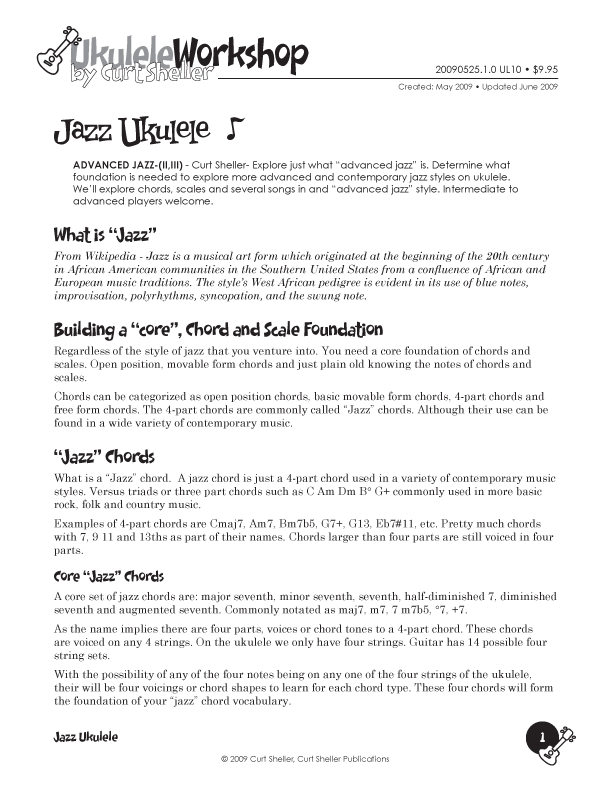
Wikipedia defines "Jazz" as a musical art form which originated at the beginning of the 20th century in African American communities in the Southern United States from a confluence of African and European music traditions. The style's West African pedigree is evident in its use of blue notes, improvisation, polyrhythms, syncopation, and the swung note.

The six essential scales are: Blues Major Pentatonic Mixolydian Dorian Aeolian and Ionian From the six essential scales, you can get through a wide variety of traditional and contemporary music. A scale is simply a collection of pitches or notes, not really a "this is a Jazz scale", "this is a Blues" or "this is a Rock scale". It's how a scale is used that really matters not its name.

The "Diminished Scale" is a symmetrical scale with a repeating pattern of whole steps and half steps. You only need three Diminished scales to cover all 15 keys.

The "Whole Tone scale" is a symmetrical scale with an equal distance been each note or scale degree.

Upper Partials or extensions for chords are the 9th, 11th, and 13ths of a chord. The 9, 11 and 13 can be altered chord tones depending on the type: e.g: b9, #9, #11, b13. These numbers, the 9, 11 and 13 refer to the scale tone/chord tone relative to the major scale used for building all chords.
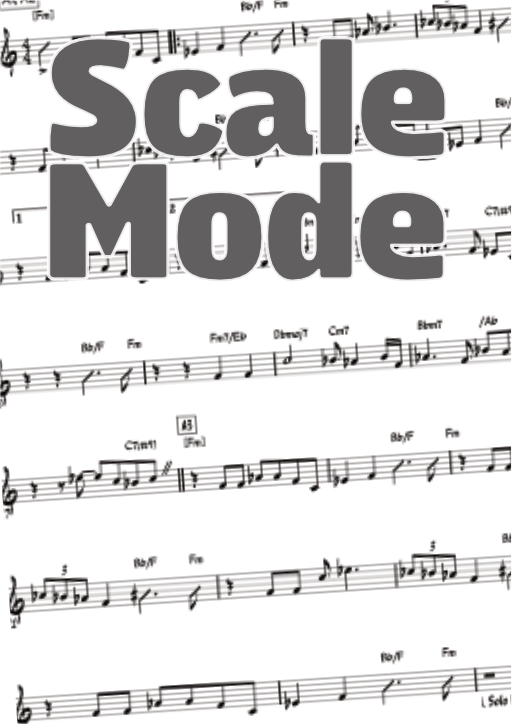
The terms "scale" and "mode" are often used interchangeably, but strictly speaking, there is a significant difference between them in music theory. Although they may share the same set of notes, a scale and a mode or modal scale are not the same thing. It's important to note that a scale and a mode can contain the same notes.

Two Feel, bVImaj7 bIImaj7, Basie Ending, Single, Double and Triple Tags, Chromatic, Take 'A' Train Ending, Shave and a Hair Cut, Lawrence Welk Ending. These are common classic songs ending that are used over and over in the standard song repertoire.

Traditionally, a "Tetrachord" is a series of four tones filling in the interval of a perfect fourth. In modern usage a tetrachord is any four-note segment of a scale or tone row including the augmented fourth (+4). The term tetrachord derives from ancient Greek music theory, it literally means four strings.**

Introductions are a composed or improvised pieces of music that introduce - sets the stage for - a song or composition. Introductions, or intro for short, are used in all types of music. In this lesson, the focus is on introductions in contemporary pop, rock, blues, country, folk and jazz styles.

Alternate fingerings for F7 in C tuning. The same fingerings would apply to C7 in G tuning and G7 in D tuning.

The "Major Scale" or Ionian scale is a diatonic scale, made up of seven distinct notes, plus an eighth which duplicates the first one octave higher. In solfege these notes correspond to the syllables Do, Re, Mi, Fa, Sol, La, Ti/Si, (Do), the Do in the parenthesis at the end being the octave of the root.

"Transposition" is the process of moving a note, chord, scale or any musical passage from one key to another key. All music can be transposed, from a single note to a complex musical score. This lesson deals with transposing chords on ukulele and transposing chords.
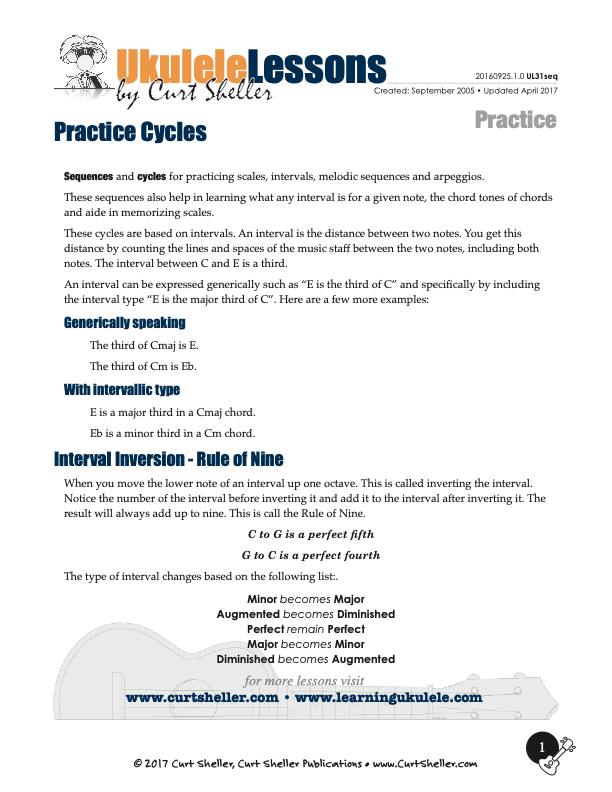
Sequences and cycles for practicing scales, intervals, melodic sequences and arpeggios.

Using chord "Voice Leading" principles we will explore all 4 voicings of core seventh chords using string family 1 2 3 4 chords.

A Chord can have alternate names based on how it is being used. A chord's function is an important determining factor in naming a chord. So unless you know the harmonic function of a given chord, you might not be able to accurately name it.
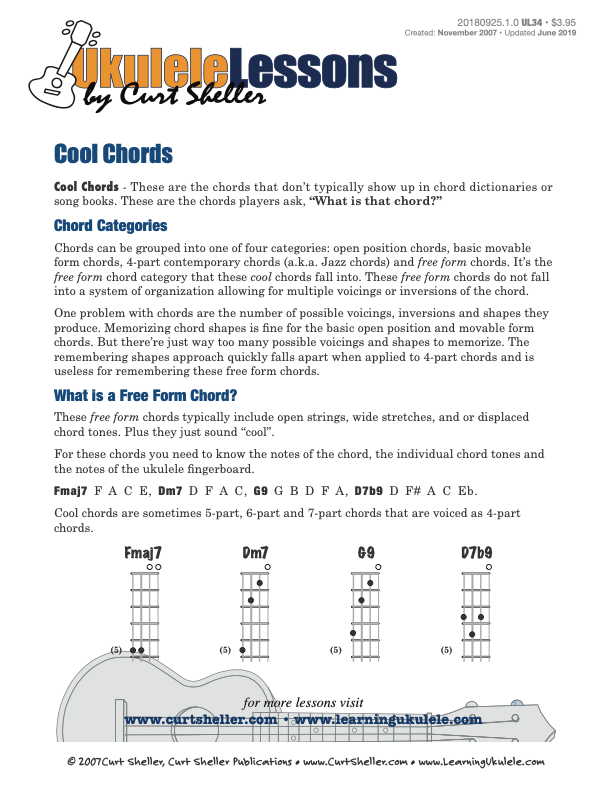
Cool Chords - These are the chords do not typically show up in chord dictionaries or song books. These are the chords players ask, "What is that chord?"

A non-traditional fingering for the G7 chord using the knowledge that the notes of a G7 chord are: G B D F.

Taking a movable "F7" chord, you can derive each of the Big Six Core Chords. 7, maj7, m7, m7b5, dim7, and aug7 from that voicing.

Taking a movable "F7" chord, you can derive each of the Big Six Core Chords. 7, maj7, m7, m7b5, dim7, and aug7 from that voicing.

Taking a movable "F7" chord, you can derive each of the Big Six Core Chords. 7, maj7, m7, m7b5, dim7, and aug7 from that voicing.

Taking a movable "F7" chord, you can derive each of the Big Six Core Chords. 7, maj7, m7, m7b5, dim7, and aug7 from that voicing.
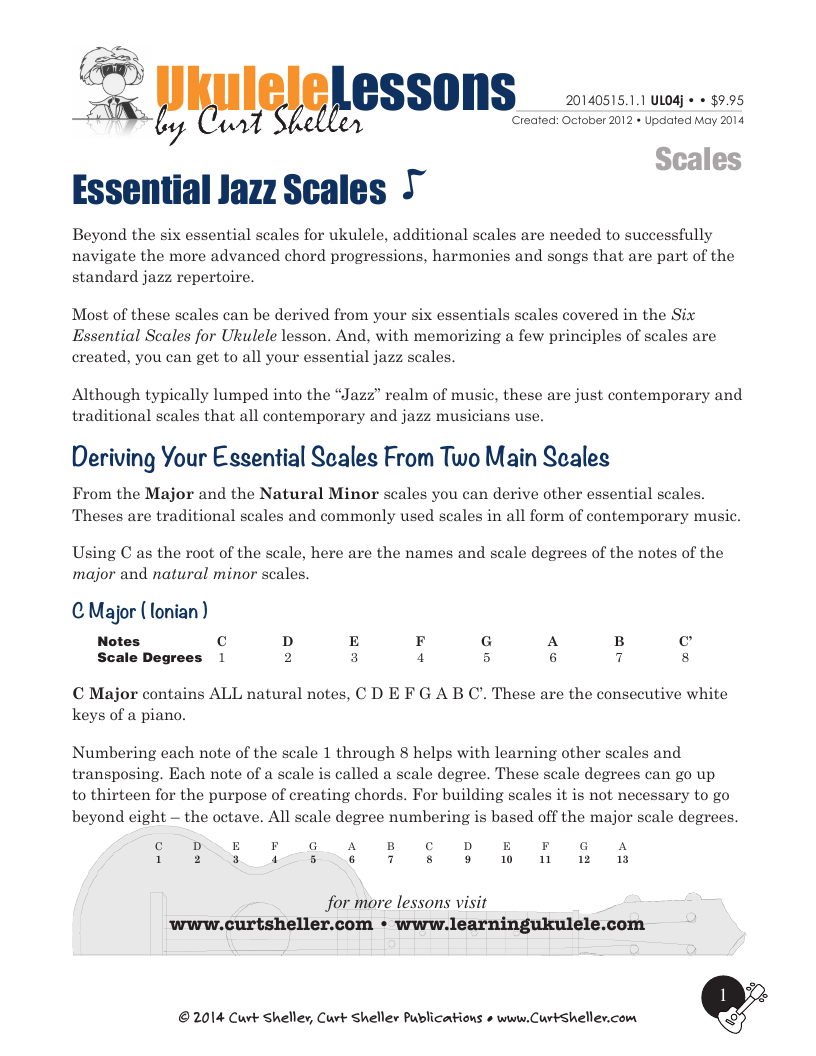
After you mastering the six essentials scales below and start to explore more advanced styles of music, especially jazz. There are a few more scales that are needed to cover the broader harmonic palette that a typical jazz tune draws from.

The Big Six Core Chords: "F6". This is the Level II of your core 4-part "Jazz" chords. The F6 is a 1 3 5 6 of the major scale, based on the root of the chord. A major 6th chord can be derived either from a seventh or major seventh chord. From a seventh chord lower the flat seventh one fret. From a major seventh chord lower the natural seventh two frets.

Using the jazz standard "All of Me" to explore jazz chords on ukulele.

Using the jazz standard "All of Me" to explore jazz chords on ukulele.

Using the jazz standard "Autumn Leaves" to explore jazz chords on ukulele.

Using the jazz standard "All the Things You Are" to explore jazz chords on ukulele.

Using the jazz standard "The Days of Wine and Roses" to explore jazz chords on ukulele.

Using the jazz standard "There Will Never Be Another You" to explore jazz chords on ukulele.

Using the jazz standard "Back Home in Indiana" to explore jazz chords on ukulele.

Using the jazz standard "Someday My Prince Will Come" to explore jazz chords on ukulele.

Using the jazz standard "Have You Met Miss Jones" to explore jazz chords on ukulele.

Using the jazz standard "Summer Samba" to explore jazz chords on ukulele.

Using the jazz standard "Sweet Georgia Brown" to explore jazz chords on ukulele.

A variation of the previous lessons using the jazz standard "Sweet Georgia Brown" to explore jazz chords on ukulele.

Using the classic Beatles cone by Paul McCartney "Yesterday" to explore jazz chords on ukulele.

Using the jazz standard "It's Only a Paper Moon" to explore jazz chords on ukulele.

Using the jazz standard "Take the A Train" to explore jazz chords on ukulele.

Using the jazz standard "Satin Doll" to explore jazz chords on ukulele. This also a great song for an introduction and exploring the very common, "II V" harmonic cell.

A variation using the jazz standard Satin Doll to explore jazz chords on ukulele.

The Big Six Core Chords: "Fm6". This is the Level II of your core 4-part "Jazz" chords. The Fm6 is a 1 b3 5 6 of the major scale, based on the root of the chord. A minor 6th chord can be derived either from a minor seventh or major sixth chord. From a minor seventh chord lower the flat seventh one fret. From a major sixth chord lower the natural third one fret.

Based on the open position seventh chords: A7, C7, E7, and G7. These movable seventh forms allow you to transpose the open position seventh chords to any key.

The Big Six Core Chords - Level I: "F7" is created from the "1 3 5 b7" of the major scale, based on the root of the chord. For "F7" the chord tones are: F A C Eb. This lesson introduces the four "F7" voicings on the string set, strings 1, 2. 3, and 4. The Chords are shown for C Tuning, Low and High G.

Learning the locations of the chord tones - the actual names of the "F7" chords, the foundation chord for our Big Six Core Chords.

The Big Six Core Chords - "F7", four voicings. From shape to chord tones to intervals and back again. Really, learning what a chord is made of.

A rare chord, a diminished triad with a major seventh. Used the support the melody when the melody is the major seventh.

Core Chords is a series of lessons for building your 4-part chords. These chords commonly called jazz chords, are really just 4-part chords used in a wide range of musical styles. Beyond basic open position chords, basic movable form chords and a core set of 4-part chords. There are just too many chords shapes too memorize. Learning the principles of how chords are constructed and the ukulele fingerboard are the way to go. Then you can create more advanced chords like 9#11, 7#5-9, 13b5, 7+9 on the fly as needed.

Not all seventh chords are actually "dominant" seventh chords. This lesson covers when is a Dominant Seventh Chord NOT truly a Dominant seventh?

"Core Chords" are a concept that I typically apply to 4-part chords and your more contemporary modern chords. This where a solid foundation of a core set of chords really help in learning the massive amount of chords that are required for play contemporary music or jazz on ukulele or guitar. Not such a task on ukulele with on one four string set of strings to build your 4-part chords vs. the theoretically possible 15 sets available for guitar.

The Lydian tetrachord is the 1 2 3 #4 of a Lydian, Lydian Dominant, or Whole Tone scale.

Commonly called "Jazz Chords", these more sophisticated, contemporary chord voicings find their way into a wide variety of music forms and styles. This lesson is the first on the series that builds your core foundation for these chords.

A "Secondary Dominant" chord is defined as any seventh chord built on a scale root that is diatonic to the key that resolves up a perfect fourth or down a perfect fifth to a full diatonic chord. These chords function as a dominant (V) chord to the next chord, serving to temporarily tonicize the following chord.

The Big Six chords include: Seventh 7, Major Seventh, Minor Seventh, Half Diminished Seventh or Minor Seven Flat Five diminished 7 , Diminished Seventh and Augmented Seventh. These six chords form a core set of chords.
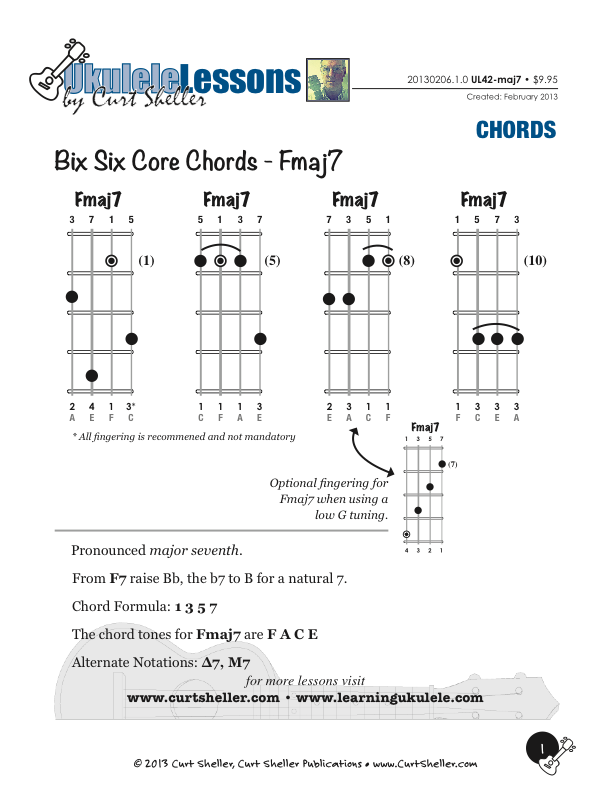
The Big Six Core Chords, Level I - Fmaj7, four voicings. Fmaj7 is a 1 3 5 7 of the major scale, based on the root of the chord. These are the four Fmaj7 chord voicings that will be used for deriving other major seventh derived chords. There are far too many chord shapes to memorize thousands of shapes.



.jpg)